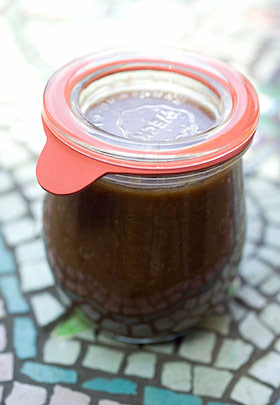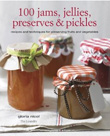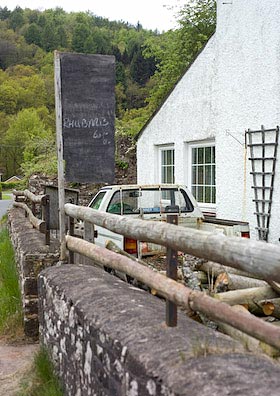
Month five Tigress’s can jam canning challenge and for May there are two ingredients to choose from; asparagus and rhubarb. Asparagus is still quite hard to come by locally. I found some in the Co-op but as it has come all the way from Peru I decided to give it a miss. I have a hard and fast rule to only buy English asparagus, which therefore means I only buy it during the 6-8 weeks that it is in season. I did buy an organic bundle in the deli here at Taurus Crafts, where my shop is situated, but it was quite expensive, so there was no way I would be prepared to mess about with such a prized ingredient other than to devour it chargrilled for my supper. So that leaves rhubarb, a crop I have already been working with for the last two and a half months but that is such a favourite of mine that I have yet to tire of it.
As luck will have it, whilst driving through the Forest of Dean I happened upon someone selling rhubarb at a very reasonable price from his smallholding. This place is a real find and I know that I will go back there often from now on, as he grows a great selection of soft fruits which will be really useful for preserving as the summer unfolds. I stupidly didn’t ask the man’s name, but will be sure too on my next visit. When I parked up and knocked on his door, my rhubarb was yet to be picked, so I knew it was as fresh as could be when the generous bundle was handed to me for a snip. Rhubarb is a strange crop. It grows really easily and can be seen in abundance in local allotments and gardens, but it is hard to find for sale and supermarkets rarely sell it. Tesco stock it most of the time but don’t always source British never mind locally. I saw it for sale earlier in the year shipped from New Zealand, which seems extraordinary when there are varieties in the UK which can grow almost all year round. So as I drove back home, with my canjam ingredient on the seat beside me, what was left to decide was what to make next.

I have already made a rhubarb marmalade, a rhubarb jam and a rhubarb cordial this year, so in the quest for something different I have decided to opt this time for a ketchup. Chutneys, sauces, relishes and ketchups are all kind of similar, except that they vary in texture and consistency. I fancied a ketchup that was smooth, with no recognisable pieces or chunks. I thought that if I kept the ingredients pale; white sugar, golden sultanas etc, I might just get away with a pinkish looking result. It wasn’t to be, as it cooked down it did take on a pinkish hue but of a beige variety. At that point I had to decide whether to stick with boring unattractive beige or whether to make the colour deeper and richer. I opted for the latter and added some balsamic vinegar. This has only a slight impact on the eventual taste of the ketchup so may seem a rather superficial consideration, but for me the downside of my ketchup is that what I have ended up with is brown. Brown, brown, brown. One of the most wonderful qualities rhubarb posesses is its colour. What a blunder, I should have made a beautiful clear rhubarb jelly instead to add to my already groaning rhubarb preserve mountain. However, now I’ve come to terms with the lack lustre appearance, the taste is making up for it. A sort of wolf in sheeps clothing scenario. I’m beginning to fantasise about dolloping ketchup on bubble and squeak, as a relish on a Double Gloucester sandwich or even with yoghurt and extra virgin rapeseed oil to dress some homegrown salad leaves. It may be brown but it is a winner all the same.
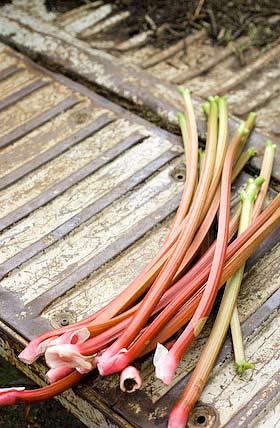
A while back I had an email from someone in the US who had bought my book. She said she was going to return the book to the shop the following day, accusing me of being ‘cavalier with ginger’. Amongst my friends, since then, this phrase has often been repeated and never fails to give us a laugh. My rhubarb ketchup is unashamedly cavalier with ginger, as rhubarb and ginger make such fine bed fellows. Obviously, if you aren’t a ginger fan, then tone it down to suit your taste. As usual when making chutneys, relishes and ketchups, that all contain vinegar, they do need a maturing phase to mellow the sharpness. This ketchup is surprisingly tasty straight away as I added some honey at the end which just takes the top edge off any harshness, but if you leave it for 3-6 weeks before opening you will find it well worth the wait. The result is fruity, spicy and I’m convinced it will be very versatile. I am not sure whether a strong enough ‘rhubarb’ vibe comes through yet, more of a lovely but general ‘fruity’ one, but I’ll see what it is like in a month or two and report back then. It is certainly worth making if you have rhubarb to spare that you hate to waste.
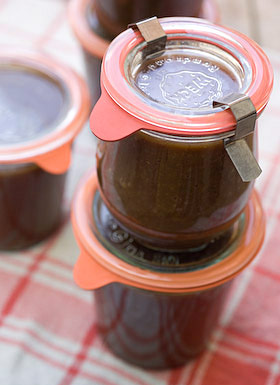
CAVALIER GINGER AND RHUBARB KETCHUP
Makes approx 1.6Kg (3 1/2 lbs)
1Kg (2lbs) chopped rhubarb
300g (10oz) onion (approx 3 med onions), chopped
325g (12oz) white sugar
1 Tbsp sea salt
600ml (1 pt) white wine vinegar
80ml (1/2 cup) balsamic vinegar
300g (10oz) raisins or sultanas
4 garlic cloves (approx 10g) peeled
4 knobs of ginger (approx 30g) peeled
2 tsp mustard seed
1 tsp allspice, ground
1tsp ground coriander
2 small dried chillis, crumbled
1/4 tsp cinnamon, ground
1/4 tsp cloves, ground
1 Tbsp honey
Place the rhubarb, onions sugar and sea salt in a non reactive preserving pan. Place the garlic, ginger, raisins (or sultanas) and vinegar in a food processor and pulse it to roughly chop everything together and break up the dried fruit. Add to the preserving pan along with the ground spices. Place the whole spices in a pestle and mortar and crush them roughly, then tip them into a piece of butter muslin, tie up in a parcel with string to secure and add to the pan.
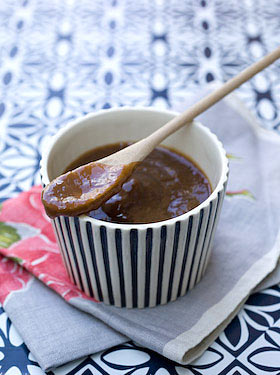
Bring to a simmer and cook until the fruit is soft, the onions are transparent and the consistency is beginning to thicken. Remove the spice bundle and push the contents of the pan through a sieve or use a food mill with a fine mesh, collecting the resulting smooth mixture. (This part of the job took rather longer than I’d have liked. Next time I will probably wizz the mixture in a blender or food processor first so it passes through the sieve faster.) Return to the pan.
Prepare the water bath, jars and seals ready for canning. For more info about how to hot water process, refer to the guide here. Add the honey to the mixture and stir. Bring the contents of the pan to a simmer and cook further if necessary until the ketchup is of a suitable consistency, like tomato ketchup. Pour into the jars leaving required headroom, seal and hot water process for 10 minutes. Remove the jars from the water bath and leave them till completely cold before testing the seals. Label and store. Leave the ketchup for at least 3 weeks before using. Without water processing the ketchup will still keep for several months unopened.
